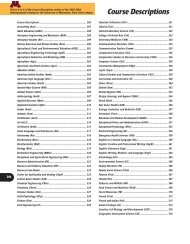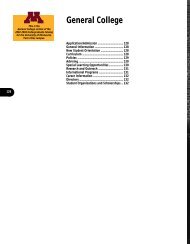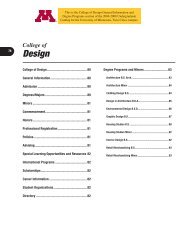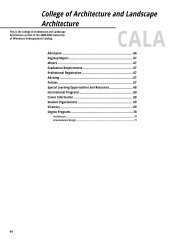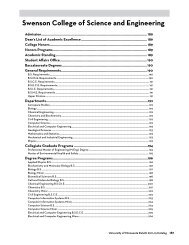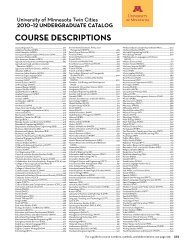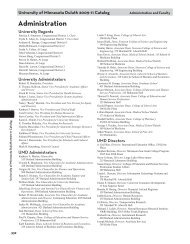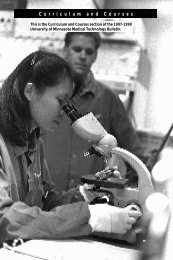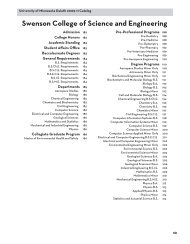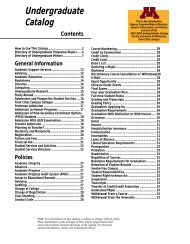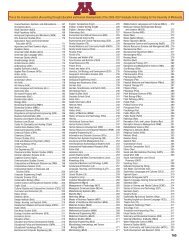CoursesâCSCI through FSCN - University Catalogs - University of ...
CoursesâCSCI through FSCN - University Catalogs - University of ...
CoursesâCSCI through FSCN - University Catalogs - University of ...
You also want an ePaper? Increase the reach of your titles
YUMPU automatically turns print PDFs into web optimized ePapers that Google loves.
Course Descriptions380Fisheries and Wildlife(FW)Department <strong>of</strong> Fisheries, Wildlife, and ConservationBiologyCollege <strong>of</strong> Natural ResourcesFW 1001. Orientation in Fisheries, Wildlife, andConservation Biology. (1 cr; A-F only)Survey <strong>of</strong> technical requirements and educationneeded for careers in fisheries, wildlife, andconservation biology. Introduction to fields <strong>of</strong> work,problems, career opportunities.FW 1002. Wildlife: Ecology, Values, and Human Impact.(3 cr. Prereq–Recommended for students without naturalscience background)Controversial issues involving specific wildlifemanagement principles/techniques.FW 1901. Freshman Seminar. (1-3 cr. Prereq–Fr)In-depth study <strong>of</strong> issues/topics related to naturalresources and the environment. Topics vary eachsemester.FW 1905. Freshman Seminar. (1-3 cr [max 6 cr]. Prereq–Fr)Issues/topics related to natural resources and theenvironment. Topics vary.FW 2001. Introduction to Fisheries, Wildlife, andConservation Biology. (3 cr. Prereq–Biol 1001 or Biol 1009)Theory/practice <strong>of</strong> fisheries and wildlifemanagement. Single species populations, ecosystem,landscape approaches. Biota, habitat, sociopoliticalaspects <strong>of</strong> human use. Case studies explore currentissues in conservation.FW 2002. Threatened and Endangered Wildlife: Causes,Consequences, and Future Conservation. (3 cr. Prereq–Intro biology course)Introduction to extinction as a process both naturaland human caused. Illustrates differences inextinction events and why we should be concernedabout rate <strong>of</strong> extinction. Definitions <strong>of</strong> current jargonused to describe imperiled species due to their legal/biological connotations. Case history examples <strong>of</strong>wildlife species that are threatened or endangered.FW 4001. Biometry. (4 cr; A-F only. Prereq–Math 1031)Basic statistical concepts such as probability,sampling space, and frequency distributions.Descriptive statistics: sample tests, linear regression(simple and multiple), ANOVA, goodness <strong>of</strong> fit,nonparameteric method and other relevant selectedtopics (e.g., clustering and classification).FW 4104. Hunting and Fishing Traditions: Field SportsReflected in Arts, Literature, and Practice. (3 cr;S-N only. Prereq–#)Philosophical foundations, history, traditions, andcurrent importance <strong>of</strong> field sports in North Americansociety. Laboratory sessions introduce making/usingmodern sport fishing equipment. Optional experientiallearning laboratory introduces safe handling/operation<strong>of</strong> firearms, leading to State <strong>of</strong> Minnesota FirearmsSafety Certificate. Lectures, invited guests, readings.FW 4105. Hunting and Fishing Traditions: Field SportsReflected in Arts, Literature, and Practice. (2 cr; S-N only)Philosophical foundations, history, traditions, andcurrent importance <strong>of</strong> field sports in North Americansociety. Laboratory sessions introduce making/usingmodern sport fishing equipment. Optionalexperiential learning laboratory introduces safehandling/operation <strong>of</strong> firearms, leading to State <strong>of</strong>Minnesota Firearms Safety Certificate. Lectures,invited guests, readings.FW 4106. Important Plants in Fisheries and WildlifeHabitats. (1 cr; A-F only. Prereq–4108)Field identification <strong>of</strong> important plants in fisheriesand wildlife habitats.FW 4108. Field Methods in Research and Conservation <strong>of</strong>Vertebrate Populations. (3 cr; A-F only. Prereq–Biol 3407)Planning/implementation <strong>of</strong> research/managementprojects. Collect/analyze data in groups. Group/individual oral/written reports. Each student keeps afield journal.FW 4129. Mammalogy. (4 cr; A-F only. Prereq–Biol 2012or #)Evolutionary and biogeographic history <strong>of</strong>mammalia. Recognize, identify, and study naturalhistory <strong>of</strong> mammals at the ordinal level, NorthAmerican mammals at familial level, and mammalsnorth <strong>of</strong> Mexico at generic level. Minnesotamammals at specific level.FW 4132. Invertebrate Diversity. (4 cr; A-F only. Prereq–Biol 1001 or Biol 2012)Survey <strong>of</strong> major invertebrate phyla from standpoints<strong>of</strong> structure, function, development, and theirenvironmental/evolutionary relationships. Focuses onmajor groups <strong>of</strong> multicelled invertebrates. Specialunit dedicated to invertebrates <strong>of</strong> Minnesota.FW 4136. Ichthyology. (4 cr. Prereq–Biol 2012)Fish biology, adaptations to different environmentsand modes <strong>of</strong> living, and evolutionary relationships.Laboratory emphasizes anatomy and identification <strong>of</strong>Minnesota fishes.FW 4191. Independent Study: Conservation Biology.(1-5 cr. Prereq–#)Individual field, library, and lab research inconservation biology.FW 4200H. Honors Seminar. (1 cr; A-F only. Prereq–FWupper div honors, #)Current topics presented by faculty/students.Lecture/discussion.FW 4291. Independent Study: Fisheries. (1-5 cr. Prereq–#)Individual field, library, and lab research in fisheries.FW 4292. Special Lectures: Fisheries. (1-5 cr. Prereq–#)Lectures in special fields <strong>of</strong> fisheries given byvisiting scholar or regular staff member.FW 4391. Independent Study: Wildlife. (1-5 cr. Prereq–#)Individual field, library, and lab research in wildlife.FW 4392. Special Lectures: Wildlife. (1-5 cr. Prereq–#)Lectures on special topics <strong>of</strong> wildlife given byvisiting scholar or staff member.FW 4401W. Introduction to Fish Physiology andBehavior. (4 cr. Prereq–Biol 1001 or Biol 1009)How life in aquatic environment has influenced fishbiology. Ionic/osmotic balance, sensory systems, gasexchange, endocrinology, growth, foraging,locomotion, reproduction, orientation/migration,toxicology.FW 4565. Fisheries and Wildlife Ecology andManagement: Field Trip. (1 cr; S-N only. Prereq–#)Ten-day field trip to Wyoming and points en routeduring spring break. Emphasizes broad range <strong>of</strong>fisheries and wildlife management, including biggame, waterfowl, endangered species.FW 4701. Fisheries and Wildlife Problem Solving. (2 cr[max 2 cr]. Prereq–FW sr or grad student or #)Management problem identification/analysis,information gathering/analysis, oral/writtenreporting. Selected management issues.FW 4801H. Honors Research. (2 cr; A-F only. Prereq–FWupper div honors, #)Independent research project supervised by facultymember.FW 4802H. Honors Research. (2 cr; A-F only. Prereq–FWupper div honors, #)Completion <strong>of</strong> honors thesis. Oral report.FW 5003. Human Dimensions <strong>of</strong> Biological Conservation.(3 cr. Prereq–[Biol 1001 or Biol 1009], Biol 3407)Survey <strong>of</strong> social, psychological, economic, policyaspects <strong>of</strong> managing/conserving wildlife, fisheries,and related resources.FW 5051. Analysis <strong>of</strong> Populations. (3-4 cr. Prereq–[[Biol1001 or Biol 1009], [FW 4001 or Stat 3011 or Stat 5021]]or #)Factors involved in regulation, growth, generaldynamics <strong>of</strong> populations. Data needed to describepopulations, population growth, population models,regulatory mechanisms.FW 5411. Aquatic Toxicology. (3 cr. Prereq–Intro chem,intro ecol, #)Pollution assessment approaches, biological effects,fate/flow <strong>of</strong> contaminants in aquatic systems, majortypes <strong>of</strong> pollutants.FW 5455. Sustainable Aquaculture. (3 cr; A-F only.Prereq–Biol 2012, Chem 1021, Math 1031] or #)Role <strong>of</strong> aquaculture in fisheries management,biodiversity rehabilitation, and food productionaround the world. Implications for sustainability <strong>of</strong>human-environment interactions in differentsocieties. Principles <strong>of</strong> fish husbandry.FW 5571. Avian Conservation and Management. (3 cr.Prereq–EEB 4134 or grad or #)Current problems in avian conservation/management. Nongame, wetland, game birds.FW 5601. Fisheries Population Analysis. (3 cr; A-F only.Prereq–[4001 or Stat 5021], Biol 3407, [Math 1142 or Math1271])Introduction to theory/methods for estimating vitalstatistics <strong>of</strong> fish populations. Using microcomputers/statistical s<strong>of</strong>tware to describe, analyze, modelattributes <strong>of</strong> fish populations. Case studies fromliterature <strong>of</strong> marine/freshwater fisheriesmanagement.FW 5603W. Habitats and Regulation <strong>of</strong> Wildlife. (3 cr;A-F only. Prereq–Biol 3407)Environmental interactions <strong>of</strong> wildlife at population/community levels. Environmental threats from humanactivities. Habitat management practices. Objectives,polices, regulations in population management.FW 5604W. Fisheries Ecology and Management. (3 cr.Prereq–EEB 4601)Managed species/systems. Applied aquatic/fishecology related to fisheries. Role <strong>of</strong> planning infisheries management. Application <strong>of</strong> managementtools, assessment <strong>of</strong> their efficacy.FW 5625. Wildlife Handling and Immobilization forResearch and Management. (2 cr; S-N only. Prereq–Generalbiology, [grad student or vet med student or FW sr], ∆)Practical techniques to maximize human/animalsafety and encourage effective operations.Preparation procedures, legal responsibilities,capture drugs/delivery systems, safety measures,ethical issues, basic veterinary procedures forhandling wildlife. Field course. Uses live animals.Food Science andNutrition (FScN)Department <strong>of</strong> Food Science and NutritionCollege <strong>of</strong> Agricultural, Food andEnvironmental SciencesFScN 1012. Sports Nutrition. (2 cr)Physiological function and metabolic fate <strong>of</strong> all sixclasses <strong>of</strong> nutrients ingested by active individuals toimprove athletic performance. Impact on physiology<strong>of</strong> ergogenic aids and various dietary supplements.Overview <strong>of</strong> these components in fulfilling energy/recovery needs for continual/progressive athleticperformance. Web-based course.FScN 1013. Dietary Supplements: scientific, regulatory,and cultural aspects. (3 cr)Use <strong>of</strong> dietary supplements in the U.S. How tomeasure risk <strong>of</strong> a dietary supplement, approach usedby National Institute <strong>of</strong> Medicine for dietaryrecommendations. Dietary Supplements Health andEducation Act, FTC responsibilities. How dietarysupplements are marketed. Other cultures as sources<strong>of</strong> supplements. Intellectual property rights <strong>of</strong>indigenous cultures. Use <strong>of</strong> supplements for health/performance. Course is online.FScN 1021. Introductory Microbiology. (4 cr)Broad introduction to the diverse world <strong>of</strong> microbesand how they impact our world in both deadly andlife-saving ways.FScN 1090. Topics. (3 cr; A-F only)Non-lab microbiology for nursing.




